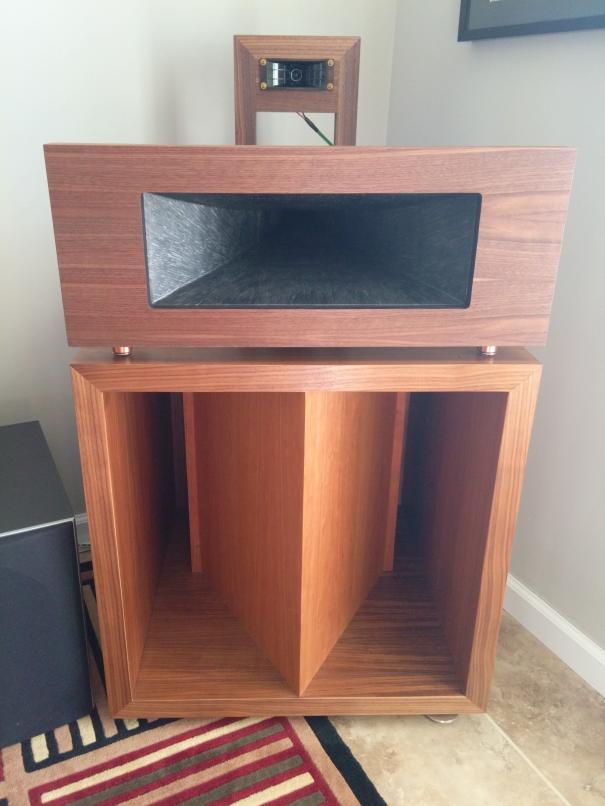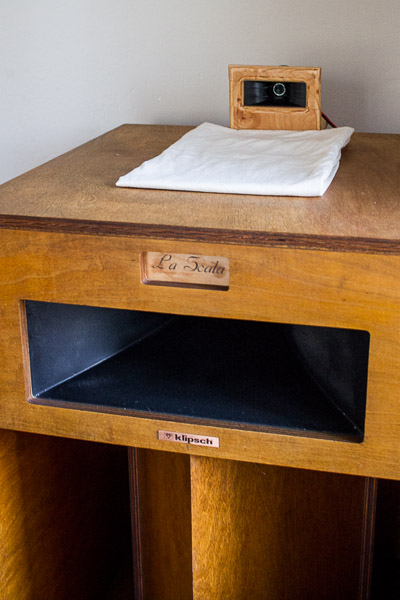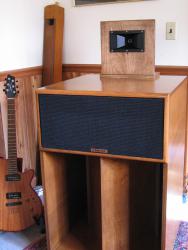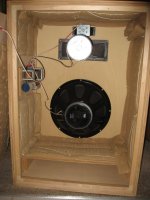Hi, I'm sure someone can assist in giving me an over view of how to time align (TA) the drivers in a speaker system.
First, I want to align the drivers in my Klipsh Cornwalls. These are in the the following configuration:
Tweeter - Horn
Mid - Horn
Woofer - Dynamic (regular)
I've got scope, DMMs, mic etc.
Have not done it and wondering how to do it. First for the above speaker.
Later on for an MTM configuration on top and side mounted woofers which are angled forward slightly.
Cheers,
First, I want to align the drivers in my Klipsh Cornwalls. These are in the the following configuration:
Tweeter - Horn
Mid - Horn
Woofer - Dynamic (regular)
I've got scope, DMMs, mic etc.
Have not done it and wondering how to do it. First for the above speaker.
Later on for an MTM configuration on top and side mounted woofers which are angled forward slightly.
Cheers,
Time aligning drivers
I am not familiar with a way to time align drivers after the build unless you are using digital signal processing. Physical time alignment of drivers is accomplished by building them into the cabinets so that the magnets/voice coils are vertically aligned so they are radiating the same info in temporal alignment, reaching the listeners ear at the same time. Maybe I do not understand your question?
I am not familiar with a way to time align drivers after the build unless you are using digital signal processing. Physical time alignment of drivers is accomplished by building them into the cabinets so that the magnets/voice coils are vertically aligned so they are radiating the same info in temporal alignment, reaching the listeners ear at the same time. Maybe I do not understand your question?
Um, you are scaring me. 
Aren't those drivers already permanently set in place?
If so there shouldn't be anything for you to do.
If you are attempting to do a time-aligned setup, you'll have to alter both the driver and crossovers. They are intimately linked in amplitude AND time/phase.
Best,
E
Aren't those drivers already permanently set in place?
If so there shouldn't be anything for you to do.
If you are attempting to do a time-aligned setup, you'll have to alter both the driver and crossovers. They are intimately linked in amplitude AND time/phase.
Best,
E
You can invert the phase (polarity) of one of the drivers, move the driver around until you hear a maximum null when driving the loudspeaker at the center frequency of the crossover, then reset the phase/polarity. This works pretty well.
You can also just listen to a good soundstage recording and move the driver (usually the tweeter) back to just above the joint on the midrange horn/driver, then move slowly back and forth in depth while someone else listens. The soundstage will immediately open up when the correct position is found.
The third method is to get yourself a UMIK-1 (or similar calibrated microphone) and load Room EQ Wizard (REW) freeware on your laptop and measure the delays looking at the a) spectrograms, b) excess group delay, or c) inverted driver SPL when moving it back and forth, looking for a relative minima in measured SPL. This is the most sensitive approach and usually yields the best results.
Chris
You can also just listen to a good soundstage recording and move the driver (usually the tweeter) back to just above the joint on the midrange horn/driver, then move slowly back and forth in depth while someone else listens. The soundstage will immediately open up when the correct position is found.
The third method is to get yourself a UMIK-1 (or similar calibrated microphone) and load Room EQ Wizard (REW) freeware on your laptop and measure the delays looking at the a) spectrograms, b) excess group delay, or c) inverted driver SPL when moving it back and forth, looking for a relative minima in measured SPL. This is the most sensitive approach and usually yields the best results.
Chris
Last edited:
You'll need to use digital delay to dial these in; otherwise each driver will need to be adjustable in the depth plane, then use this procedure to find the different physical offsets starting with the woofer-mid, then mid-tweeter [ignore the Altec specific references]: https://audioroundtable.com/misc/Altec_AN-9.pdf
GM
GM
If using digital delay, like a DSP crossover, then I recommend using REW and a calibrated microphone like I discussed above. You'll see the time offsets clearly by using the spectrogram (impulse) view. Second to this, you can see the delay in the excess group delay plot as group delay growth around the crossover frequency.
You can also step the delay on the upper frequency channel sequentially around the calculated point using an inverted polarity channel, then look for minimum SPL on-axis. Some DSP crossover software that runs on a laptop or PC will convert delays in microseconds to linear distance for you if you input the ambient temperature.
Chris
You can also step the delay on the upper frequency channel sequentially around the calculated point using an inverted polarity channel, then look for minimum SPL on-axis. Some DSP crossover software that runs on a laptop or PC will convert delays in microseconds to linear distance for you if you input the ambient temperature.
Chris
If using digital delay, like a DSP crossover, then I recommend using REW and a calibrated microphone like I discussed above. You'll see the time offsets clearly by using the spectrogram (impulse) view. Second to this, you can see the delay in the excess group delay plot as group delay growth around the crossover frequency.
The issue here is you still have to deal with driver to driver phase matching, and that is just as hard in digital world as in passive. Also important, as Bill Waslo often points out, this alignment holds for 1 position only. Move off axis and it's no longer valid.
Rather than transforming the entire speaker, simpler to use something like Dirac Live or it's OSS equivalent ( ReQ? ) to time align the whole thing but leaving the passive portions of the speaker in tact.
Best,
E
If you are into computer audio, you can use DSP software like Acourate or Audiolense to create digital XO's and time align your drivers. Here I used Acourate to time align Bob Crite's Cornscala's that would be similar to your Klipsch Cornwalls. There are a lot of manual steps.
Here I use Audiolense to time align a two way JBL system. The time alignment process is fully automated, predictable and repeatable.
Contrary to popular belief, time alignment holds for more than one position. In the case of the 3 way above, I measured at 14 locations around a 6' x 2' grid area at the listening position and the time alignment remains perfect. Details in my sig.
With the large driver z offsets in the Cornwall's, I predict you will hear an improvement like I have described in the articles. Good luck!
Here I use Audiolense to time align a two way JBL system. The time alignment process is fully automated, predictable and repeatable.
Contrary to popular belief, time alignment holds for more than one position. In the case of the 3 way above, I measured at 14 locations around a 6' x 2' grid area at the listening position and the time alignment remains perfect. Details in my sig.
With the large driver z offsets in the Cornwall's, I predict you will hear an improvement like I have described in the articles. Good luck!
Contrary to popular belief, time alignment holds for more than one position. In the case of the 3 way above, I measured at 14 locations around a 6' x 2' grid area at the listening position and the time alignment remains perfect. Details in my sig.
It's not belief if it's measurable.
Alignment will change in the axis of the drivers' arrangement. How much depends on the center-to-center spacing, measuring distance and crossover frequency. It is what determines the vertical coverage angle for most speakers after all. It's not hard to believe that little change would be measured at a fair distance from a wide-coverage speaker over 2' of vertical measurements though.
@Everyman, Well that is a lot of info. I'm going to continue reading etc. Obviously it's not a simple 1.2.3 procedure.
No, I don't want to destroy the speakers.
@casko5....That is a start. I just don't know about moving the tweeter back into the cabinet... it's limited by the houn mounting. If i recall, it is about six inches deep while the mid horn might be about 12-14 inches deep. Going from memory but I get the idea. I do have some software, but not sure on these speakers how to hook them up. The ELE crossover.
@Mitchba, will be going through your links.... ...and more links. Now I wish there was a method to do brain dumps.
While I don't have Acourite, I can use another DSP solution from the SymNet folks. Somewhere there is an REW that I can use to start with.
I do have calibrated mic on loan.
Thanks,
Cheers,
No, I don't want to destroy the speakers.
@casko5....That is a start. I just don't know about moving the tweeter back into the cabinet... it's limited by the houn mounting. If i recall, it is about six inches deep while the mid horn might be about 12-14 inches deep. Going from memory but I get the idea. I do have some software, but not sure on these speakers how to hook them up. The ELE crossover.
@Mitchba, will be going through your links.... ...and more links. Now I wish there was a method to do brain dumps.
While I don't have Acourite, I can use another DSP solution from the SymNet folks. Somewhere there is an REW that I can use to start with.
I do have calibrated mic on loan.
Thanks,
Cheers,
Last edited:
@casko5....That is a start. I just don't know about moving the tweeter back into the cabinet...it's limited by the houn mounting. If i recall, it is about six inches deep while the mid horn might be about 12-14 inches deep.
Going from memory but I get the idea...
I believe the idea is to move the tweeter on top of the cabinet, like this:

or this:

or this:

Chris
Last edited:
but gang, these speakers were designed they way they were! I mean, I'm all for time alignment, but that folded horn probably leaves the woofer another foot behind the cabinet, acoustically speaking.
I think great phase matching is where you should leave this project at, and that's probably leaving everything as is.
Best,
E
I think great phase matching is where you should leave this project at, and that's probably leaving everything as is.
Best,
E
Well non-destructively you could try rePhase software to correct things and have a listen. Not sure how far it's practical to go with rePhase, but it doesn't hurt to try.
rePhase, a loudspeaker phase linearization, EQ and FIR filtering tool
rePhase, a loudspeaker phase linearization, EQ and FIR filtering tool
I'd be surprised if the mid didn't need some setback too.
GM
Yes, IIRC, the Cornscala type I is using a 400 Hz fc horn, so the offset with the bass bin to midrange is about 7 inches, which is right on the edge of being 1/4 wavelength at the crossover frequency. So a set back of a couple of inches on the woofer, or a move of the midrange horn forward by the same amount would get you within 1/4 wavelength alignment on the midrange to woofer.
Ahhh, ok.
So your only real options involve DSP anyway, might as well leave the speaker alone, and use RePhase/Dirac/etc. to do it all at once.
Attempting to do it as a multi-way active job is a lot more work. You can of course delay each driver, but the crossover points/slopes are just as, if not more, comlpicated.
You can of course delay each driver, but the crossover points/slopes are just as, if not more, comlpicated.
Try grabbing a copy of XSim, and attempt to do a 3-way time aligned with 3 default drivers and you'll see what I'm talking about. Just being able to delay a driver in time is not nearly enough.
So your only real options involve DSP anyway, might as well leave the speaker alone, and use RePhase/Dirac/etc. to do it all at once.
Attempting to do it as a multi-way active job is a lot more work.
Try grabbing a copy of XSim, and attempt to do a 3-way time aligned with 3 default drivers and you'll see what I'm talking about. Just being able to delay a driver in time is not nearly enough.
- Status
- This old topic is closed. If you want to reopen this topic, contact a moderator using the "Report Post" button.
- Home
- Loudspeakers
- Multi-Way
- Time Aligning Drivers, how to?
